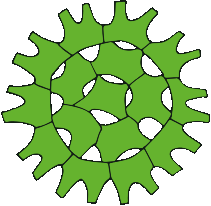This week there was a message from both DIATOM-L and ALGAE-L about a set of taxa names they have been developing in USA: http://diatom.ansp.org/nawqa/Taxalist.aspx.Makes me wonder about the cleverness in making all kinds of - more or less taxonomically correct - algae lists in different countries. When does the dawn of international algae lists break through? Nordic Microalage has made a nice start. But a larger European co-operation on this subject would not be harmful. Not to talk bout the rest of the world. Step by step... Do take a look at the rest of the pages of the Phycology Section, Pa...
Read More
Month: April 2012
A cordial blue-green algae
They really are heart shaped, the cells of of the blue-green algae Gomphosphaeria: Although it's not as nicely visible here as in Joostens (2006) book, see page 153. This is the type species Gomphosphaeria aponina, because it has a thin, yet very clear layer enveloping the individual cells: There used to be a lot of different Gomphosphaeria-species, but then - in 1980's - misters Komárek and Hindák took a closer look at these species and divided three genera out of this group: Gomphosphaeria Kützing 1836, Woronichinia Elenkin 1933 and Snowella Elenkin 1938. They al...
Read More
Brown beans
I saw these brown beans hanging on a Tabellaria today:
and was wondering, what was this again..? Being sure I had seen a picture like this somewhere I tried to recall in which book. Was it in the Yellow-green algae (Xanthophyceae) book? Or was it in the Green algae book (Chlorophyceae, Chlorococcales) from Komárek the Great and Fott the Fine? Or perhaps in the Dinophyceae book??There is something that makes one think about the Xanthophyceae: the thick, transparent walls and even some red oil dops. But the color is very dark... and it looked like they did not put m...
Read More
Coastal Phytoplankton – a book
The Photo Guide for Northern European Seas, Coastal Phytoplankton book from Alexandra Kraberg, Marcus Baumann and Claus-Dieter Dürselen is worth taking a look in.The size is handy, the photo's are fine, the quality of paper very good. It has nice, clear drawings to clarify the different structures in plankton organisms. Every species has one whole page for itself, with mostly good photos and drawings. Furthermore on top of every page you can find a bulk of information of the species in a very concentrated, yet not in a cluttered manner. Very handy are the tips about the similar species. When ...
Read More
